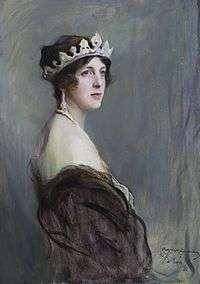Socialite
A socialite is a person (usually from a wealthy, or aristocratic background) who plays a prominent role in or is very frequently involved in high society. A socialite generally spends a significant amount of time attending various fashionable social gatherings.[1][2]
United Kingdom
Historically, socialites in the United Kingdom were almost exclusively from the families of the aristocracy and gentry.[3] Many socialites also had strong familial or personal relationships to the British royal family.
Between the 17th and early 19th centuries, society events in London and at country houses were the focus of socialite activity.[3] Notable examples of British socialites include Beau Brummell, Lord Alvanley, the Marchioness of Londonderry, Daisy, Princess of Pless, Lady Diana Cooper, Mary Constance Wyndham, Lady Ursula d'Abo, and the Mitford sisters. Since the 1960s, socialites have been drawn from a wider section of society more similar to the American model, with many socialites now coming from families in business or from the world of celebrity. Despite this, the notion of the Sloane ranger still emphasises many socialites' connections to Britain's ruling class.[4] The Royal Borough of Kensington and Chelsea is widely regarded as the current home of socialite activity in the UK. The television show Made in Chelsea has explored the lifestyles of young socialites living in London in the 21st century.[5]
United States
American members of the Establishment, or an American "society" based on birth, breeding, education, and economic standing, were originally listed in the Social Register, a directory of the names and addresses of the "preferred social contacts" of the prominent families in the 19th century. In 1886, Louis Keller started to consolidate these lists and package them for sale.[6]
18th and 19th centuries
The concept of socialites dates to the 18th and 19th century. Most of the earliest socialites were wives or mistresses of royalty or nobility, but being a socialite was more a duty and a means of survival than a form of pleasure. Bashful queens were often forced to play gracious and wealthy hostess to people who despised them. Mistresses had to pay for their social reputation and had to use their social skills to obtain favor in the court and retain the interest of their lovers.[7]
With the increase of wealth in America in the 19th century, being a socialite developed into a role that brought power and influence.[7]
20th century
The word "socialite" appears the first time in English language in 1928, in Time magazine.[8]
21st century
In the 21st century, the term "socialite" is still attached to being wealthy and socially recognized. The lines between being a socialite and celebrity with an exuberant partying lifestyle have since become blurred due to the influence of both popular culture and the media, particularly when the status of being a celebrity is largely due to that lifestyle. Celebrity Paris Hilton is an example of a 21st-century socialite due to her ability to attract media attention and fame based on her connections and associations. Hilton is the great-granddaughter of Conrad Hilton, the founder of Hilton Hotels & Resorts, and heiress to the Hilton Hotel fortune. Due to her outrageous lifestyle, Hilton was hailed by the media as "New York's leading It Girl" in 2001.[9]
Gossip Girl, an American television series airing between September 2007 and December 2012, focuses on the lives of New York City socialites who live on Manhattan's Upper East Side. The show is a strong influence on how socialites are regarded in the 21st century because of the presence of scandal, wealth, and fashion in each episode. Pop culture gives the impression that by simply being wealthy and fashionable, an individual has the opportunity to become famous. Consequently, it is an individual's ability to climb the social ladder due to his or her wealth and recognition that makes them a socialite.
According to The New York Times, socialites spend between $98,000 and $455,000 per year (young and old, respectively) to maintain their roles as successful socialites.[10] Just the evening wardrobe of an individual regularly attending society functions can cost $100,000 annually.[11] Examples of American socialites include: Tiffany Trump, Kim Kardashian, Jill Kelley, Tinsley Mortimer, Olivia Palermo, Lauren Santo Domingo, Derek Blasberg, and Jean Shafiroff.
Famous Historical Socialites
 Caroline Schermerhorn Astor (1830-1908)
Caroline Schermerhorn Astor (1830-1908) Jacqueline Kennedy Onassis (1929-1994)
Jacqueline Kennedy Onassis (1929-1994) Alva Vanderbilt Belmont (1853-1933)
Alva Vanderbilt Belmont (1853-1933) Wallis Simpson, Duchess of Windsor (1896-1986)
Wallis Simpson, Duchess of Windsor (1896-1986) Edith Vane-Tempest-Stewart, Marchioness of Londonderry (1878-1959)
Edith Vane-Tempest-Stewart, Marchioness of Londonderry (1878-1959)_(A).jpg) Lady Randolph Churchill (1854-1921)
Lady Randolph Churchill (1854-1921) Kathleen Cavendish, Marchioness of Hartington (1920-1948)
Kathleen Cavendish, Marchioness of Hartington (1920-1948) Beau Brummell (1778-1840)
Beau Brummell (1778-1840)
See also
| Wikimedia Commons has media related to Socialites. |
| Look up socialite in Wiktionary, the free dictionary. |
- Bon viveur
- Conspicuous leisure
- Debutante
- Elitism
- Famous for being famous
- Ingroups and outgroups
- International Debutante Ball
- It girl
- Jet set
- List of American heiresses
- Sloane Ranger
- Social environment
- Upper class
- White Anglo-Saxon Protestant
- Yuppie
References
- "Socialite definition". Reverso Dictionary. Retrieved 2010-10-28.
- "Socialite". Merriam-Webster Online. Retrieved 2010-10-28.
- Biressi, Anita; Nunn, Heather (23 Apr 2013). Class and Contemporary British Culture. Palgrave Macmillan.
- "ON THE TRAIL OF LONDON'S SLOANE RANGERS". The New York Times. 25 March 1984.
- "Made in Chelsea documents the affairs of 12 young socialites in West London". The Independent. 26 April 2011. Retrieved 26 January 2015.
- "About Us". Social Register Association. Retrieved 2013-07-31.
- "What is a Socialite?". wiseGEEK. Retrieved 2013-12-30.
- https://www.etymonline.com/word/socialite
- ""Paris Hilton Biography – Facts, Birthday, Life Story". Biography.com.
- "The True Cost of Being an NYC Socialite". Business Insider. Retrieved 2013-12-30.
- Ferla, Ruth La (2013-06-21). "What Price Generosity?". The New York Times. ISSN 0362-4331. Retrieved 2015-06-26.